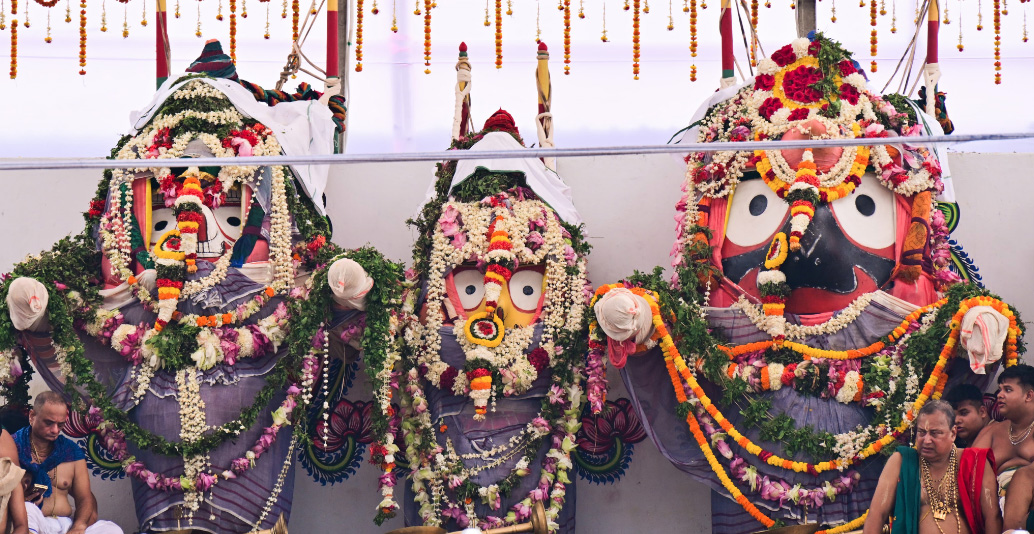Puri: Holy City of Puri is indeed abuzz with preparations for the auspicious Snana Jatra, on 11 June, a significant precursor to the Annual Rath Jatra. This ceremonial bathing ritual of Lord Jagannath, Lord Balabhadra, and Devi Subhadra is a spectacle of immense religious devotion and intricate administrative planning.
The Snana Jatra, also known as Devasnana Purnima, falls on the full moon day of the Jyestha month. It is a highly sacred event, signifying the Lords’ ceremonial bath with 108 pots of consecrated water, believed to purify and rejuvenate them before their grand journey during Rath Jatra.
Shree Jagannath Temple Administration (SJTA) Chief Administrator Dr.Arabinda Kumar Padhee has chalked elaborate Religious and Administrative arrangements for the Celebrations .
Pahandi (Procession): The Trinity, Lord Jagannath, Lord Balabhadra, Devi Subhadra, and Sudarshana Chakra, are brought in a grand procession called ‘Pahandi’ from the sanctum sanctorum to the ‘Snana Mandap’ (bathing platform) located outside the main temple. This is a rare occasion for devotees to witness the deities in their full form outside the Garbhagriha.
Jala Bije and Puja: The core ritual involves bathing the deities with 108 pots of holy water drawn from the ‘Suna Kua’ (Golden Well) within the temple premises. This elaborate bathing ceremony is accompanied by Vedic chants, rituals, and prayers performed by the temple priests (sevayats).
Hati Besha (Elephant Attire): After the ceremonial bath, the deities are adorned in the majestic ‘Hati Besha’ or elephant attire. This unique costume is a significant visual spectacle and is believed to have originated from a legend where Lord Jagannath appeared in the form of Lord Ganesha to a devotee named Ganapati Bhatta.
Sahana Mela Darshan: Following the Hati Besha, devotees are allowed a special public darshan known as ‘Sahana Mela,’ offering them a rare opportunity to see the deities from close quarters.
Anasara Period: After Snana Jatra, the Trinity enter a period of seclusion for 15 days, known as ‘Anasara.’ During this time, they are believed to “fall ill” from the extensive bathing and are kept away from public view. Only a select group of Daitapati servitors attend to them, performing secret rituals and offering herbal remedies. The temple remains closed to the public during this period.
Ritual Timetable: The Shree Jagannath Temple Administration (SJTA) meticulously finalized the ritual schedule in coordination with the Chhatisha Nijog (apex body of servitors) to ensure a disciplined and seamless execution of the ceremonies. Specific timings for Mangalarpana, Pahandi, Jala Bije, Puja, Chhera Pahanra (symbolic sweeping of the platform by the King of Puri), Hati Besha, and Bahuda Pahandi are strictly adhered to.
Given the massive influx of devotees expected, ACS Home Satayabrata Sahu has extended all out support for the State Police. And the Puri District Administration and State Police have put in place comprehensive security, crowd management, and traffic arrangements.
Security Deployment: A substantial police force, including 70 platoons, along with senior officers and additional SP-rank officers, will be deployed for the safety of devotees and to maintain law and order. Special emphasis is placed on crowd control, traffic regulation, and ground management. Forces are strategically positioned inside and outside the Srimandir, as well as at the Puri beach.
AI Surveillance and Monitoring: A significant highlight this year is the implementation of advanced AI cameras. Over 100 AI cameras have been installed to monitor the security and law and order situation 24/7. These cameras are linked to a central control room for real-time oversight and to facilitate prompt responses to any untoward incidents. An Integrated Command Control Centre (ICCC) is established to coordinate efforts across various departments.
Traffic Management and Advisories:
Restrictions: Four-wheelers are restricted from the Medical Chhak area up to Srimandir. The stretch from Medical Chhak to Srimandir will become a no-vehicular zone from the evening of June 10th.
Parking Facilities:
Four-wheelers: Designated parking areas are available at Jail Road and Saradhabali for vehicles coming from Bhubaneswar. Those from Konark can also use Saradhabali, and vehicles from Brahmagiri can park at Yatrika. Alternate parking zones like Digabareni, Blue Flag Beach Parking, and Neelachal Ashok Parking will be used once primary areas reach capacity.
Two-wheelers: Parking is arranged at the Municipality Market Complex and Old Jagannath Ballav Parking.
Traffic Flow: Specific routes are designated for vehicles arriving from different directions (Brahmagiri, Bhubaneswar, Konark) to ensure smooth flow and avoid congestion. Return routes are generally the same as entry routes.
Three-wheelers: Auto-rickshaws have designated routes and are prohibited from accessing roads around the Jagannath Temple, including the Lion’s Gate from Solakhia Baragachha Chhak, North Gate from Biseswari Temple, and Mochi Sahi Chhak to Brusav Chhak.
Crowd Control and Facilities:
Barricades: Barricades are strategically placed to ensure disciplined darshan and smooth crowd movement.
Mock Drills: Full-scale mock drills are conducted with the joint participation of multiple departments (police, fire services, health, temple administration, volunteers) to test readiness for managing large crowds, emergency response, and to identify and address any gaps in planning.
Devotee Amenities: Provisions for water, shade, and proper queue systems are arranged for the convenience of devotees.
Emergency Preparedness: Medical response teams and temporary aid stations are set up, and fire units rehearse evacuation procedures.
Helpline and Assistance: 24×7 helplines (112 / 6370967100 / 06752-232551) are operational for public convenience.
Anti-Social Elements: The police conduct drives to apprehend anti-social elements and ensure a safe environment.
Lifeguards: Lifeguards are deployed at the Puri beach for public safety.
The Snana Jatra is not just a religious ritual but a significant logistical undertaking that requires precise coordination between various government agencies and temple authorities to ensure a safe, smooth, and spiritually fulfilling experience for millions of devotees


